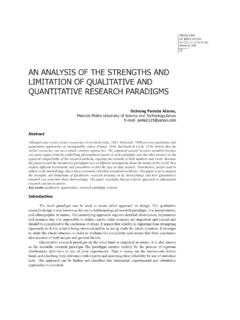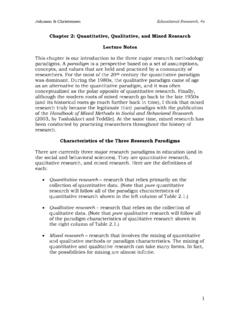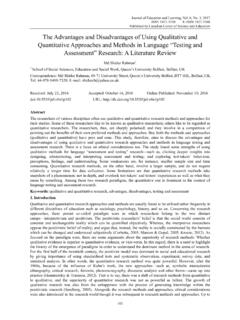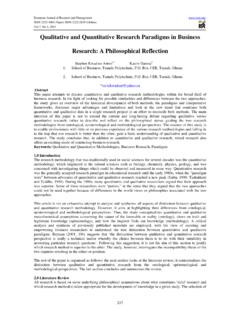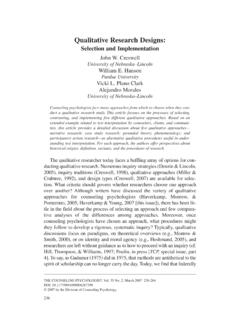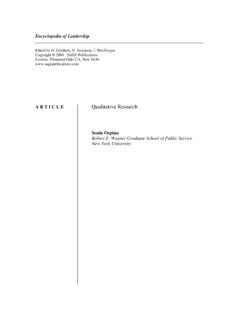Transcription of The Usefulness of Qualitative and Quantitative Approaches ...
1 Journal of Education and Practice ISSN 2222-1735 (Paper) ISSN 2222-288X (Online). , , 2016. The Usefulness of Qualitative and Quantitative Approaches and Methods in Researching Problem-Solving Ability in Science Education Curriculum EYISI DANIEL. Doctoral Student at Queen's University Belfast, UK. ABSTRACT. research in science education is to discover the truth which involves the combination of reasoning and experiences. In order to find out appropriate teaching methods that are necessary for teaching science students problem-solving skills, different research Approaches are used by educational researchers based on the data collection and analysis used at a given time. Though Qualitative and Quantitative research methods lies on separate continuum, they all aimed at identifying educational problems using different approach. This study critically examined the Usefulness of both Qualitative and Quantitative Approaches in researching problem-solving ability in science education curriculum.
2 In doing this, six articles relating to problem-solving were examined to show the Usefulness of both Qualitative and Quantitative research Approaches to educational research . Advantages, disadvantages, strengths and weaknesses of both methods were discussed. Ethical consideration in relation to research in problem-solving instructions were discussed as well as suggestion for future research . 1. Introduction Progressive curriculum school of thoughts emerged perhaps as a result of the inability of a traditional oriented curriculum to meet the dynamic societal needs, values, and aspirations because curriculum is argued to be an avenue for solving problems of the society (Udom, 2013). Sciences were included in the progressive curriculum to inculcate and equip the learner with the necessary skills and experiences for solving problems around the learner and society at large as opposed to the traditional school of thought curriculum whose main aim is only to teach learners how to read and write.
3 Today, we all solve problems in our daily lives. We teach problem-solving to our students' day-by-day using sciences instruction curriculum as planned and organized experiences. Science education produces scientists as well as artisans for national technological and economic development. As a result of this, (FME 2004 & 2008) stresses that science education shall lay emphases on the teaching and learning of science process and product so as to inculcate problem-solving abilities on the students. Problem- solving was said to be a special case of meaningful learning (Ausubel, 1968). This can perhaps be associated to a definitive concept of problem-solving as the mental process which is used in arriving at a best answer to an unknown subject to a set of unknown (Woods, 1987). In an attempt to find out the appropriate teaching methods to be used in teaching science students problem-solving skills, educational researchers use different research Approaches based on the methods of their data collections.
4 There has been controversy over the Usefulness of Qualitative or Quantitative approach in educational research (Cohen, Manion & Morrison, 2011). This paper will discuss the advantages and disadvantages of Qualitative and Quantitative research Approaches and methods, evaluating their Usefulness as well as any ethical considerations in relation to problem-solving instruction in science education curriculum with indication of the dominant Approaches in the area. First of all, I will outline the advantages and disadvantages of Qualitative and Quantitative research Approaches and methods. Secondly, I will discuss the issue of problem-solving in science education. Next I will highlight the strength and weaknesses of Qualitative and Quantitative research Approaches and methods on the issue. Then I will analyse few necessary Qualitative and Quantitative research studies and the dominant Approaches on problem-solving instruction. Finally, I will evaluate their Usefulness as well as any ethical consideration in relation to problem-solving instruction.
5 2. Philosophical Framework The essence of educational research is to improve educational programmes. Perhaps, research may be seen as an honest enterprise where reasoning, interest, critical thinking, experiences and expertise are combined with the purpose of discovering the truth so as to find solutions to problems confronting education through investigation and analyses. There are no standard procedures of carrying out research . In other words, research is not a routine 91. Journal of Education and Practice ISSN 2222-1735 (Paper) ISSN 2222-288X (Online). , , 2016. activity because it suggests mystical activity (Leedy and Ormrod, 2014, p141-190). research designs are either classified as Qualitative , Quantitative research or mixed method. Method of research is generally believed to reside in paradigms and communities of scholars (Cohen, 2011, p4). Kuhn (1970) (cited in Hammersley (2012) examines paradigm as a set of philosophical assumptions about the phenomena to be studied (ontology), how they can be understood (epistemology), and the purpose and product of research .)
6 Kuhn's work accounts for the understanding of the nature of Qualitative and Quantitative research Approaches used in educational research today. The paradigms are characterized by the methods of data collection and analysis as well as methodological Approaches to research which has been generating much controversy among researchers. Bryman (2008, p22-23) argues that Qualitative and Quantitative research differs in their paradigmatic Approaches with respect to their epistemological (ways of knowing and enquiry in nature of reality) and ontological (what is to be known and assumptions about the nature of reality) foundations. In ontological orientations, Qualitative and Quantitative researchers are constructivism and objectivism respectively in terms of their strategies. However, in epistemological orientation, Quantitative researchers are objectivists and positivists in their research approach while Qualitative researchers are subjectivists and anti-positivists in their research approach (Creswell, 2009, p4- 17).
7 Johnson and Christensen (2012, p31) stated that a paradigm is an approach about research or doing research . The authors identified Qualitative , Quantitative and mixed research as the three major paradigms in educational research . The authors were however silent on the foundation or orientation on which these paradigms were classified. Guba and Lincoln (2005, p183), in their work, argue that paradigm are beliefs that guide that guide one in his activity . Guba and Lincoln acknowledged that paradigms are human constructions and therefore subject to change. The authors refer to paradigm as encompassing four distinct terms which are: ethics (axiology), epistemology, ontology, and methodology when dealing with positivist ( Quantitative researcher) and social constructivist ( Qualitative researcher). Guba and Lincoln (1994, p109) stated four distinct paradigms associated with social researches as being: constructivism, critical theory, positivism and postpositivism.
8 Constructivism and critical theory are associated with Qualitative research , while positivism and postpositivism are associated with Quantitative research . The next section will consider the advantages and disadvantages of Qualitative and Quantitative research Approaches and methods in relation to problem-solving instruction in secondary school science education curriculum. Advantages and disadvantages of Qualitative and Quantitative research Over the years, debate and arguments have been going on with regard to the appropriateness of Qualitative or Quantitative research Approaches in conducting social research . Robson (2002, p43) noted that there has been a paradigm war between constructivists and positivists. But the two methods are incompatible in the sense that each has its own unique ways of gathering and analysing data. The two methods are tools used to achieve the same goal with different techniques and procedures, despite the fact that they have different strengths and logic (Paul, 2007, p4; Maxwell, 2004, p3-11; Maxwell and Loomis, 2002, p241-271).
9 Both research Approaches fall on a research continuum (Creswell, 2009, p3 and Johnson and Christensen, 2012, p32). It is interesting to note that in the research Approaches , whether Qualitative or Quantitative method, the key words explaining phenomena are used irrespective of the approach (Muijs, 2004, p7-45). All the definitions, criticisms, arguments and counter arguments made by authors about the research Approaches border only on the methods of data collection, analysis and summary of the results. The fact is that neither constructivists nor positivists have claimed that their instruments are more reliable and valid than the other, thus showing that they are meant to achieve the same goal. It is worth knowing that since Qualitative and Quantitative research Approaches are based on divergent theories and assumptions, one should be more advantageous than the other and vice versa, depending on the nature of research and data collection methods.
10 Advantages of Qualitative research Approach Berg and Howard (2012) characterise Qualitative research as meanings, a concept, a definition, metaphors, symbols and a description of things. This definition clearly show that Qualitative research contains all necessary instruments that can evoke recall which aids problem-solving. Qualitative data instruments such as observation, open-ended questions, in-depth interview (audio or video), and field notes are used to collect data from participants in their natural settings. The methods employed in data collection give full description of the research with respect to the participants involved. The participants' observation and focused group nature of 92. Journal of Education and Practice ISSN 2222-1735 (Paper) ISSN 2222-288X (Online). , , 2016. Qualitative research approach create wider understanding of behaviour. Hence, Qualitative research approach provides abundant data about real life people and situations (De Vaus, 2014, p6; Leedy and Ormrod, 2014).










